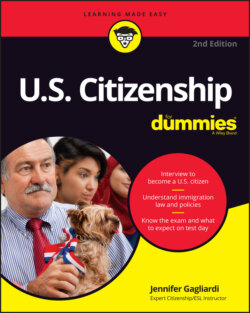Читать книгу U.S. Citizenship For Dummies - Jennifer Gagliardi - Страница 18
Pursuing employment opportunities
ОглавлениеIf you want to immigrate to the United States based on the fact that you have a full-time, permanent employment opportunity waiting for you here, both you and your prospective employer must meet a list of specific qualifications. Although one of the goals of the USCIS is to provide the United States with a strong and stable workforce, the USCIS also wants to be sure that immigrants aren’t taking jobs that would otherwise go to unemployed U.S. citizens.
Before you even get started, keep in mind that your prospective employer has to first certify the position with the Department of Labor. This Labor Certification is required to show there are no qualified, available U.S. workers to fill the job.
The USCIS grants permanent residence based on employment skills in one of five categories:
Priority Workers (category EB-1) have extraordinary ability in the arts, education, business, science, or athletics, or are considered to be outstanding professors or researchers. Notice the superlatives: extraordinary, outstanding. This category is one of the most difficult ones to qualify for unless you’re a Nobel Prize winner or hold other such prestigious and public accolades in your given field. You may qualify, however, by presenting extensive documentation proving your professional or academic achievements in one of the listed fields as well as evidence of your financial success in your field and your ability to substantially benefit the United States. Another way to qualify for the Priority Workers category is if you happen to be a manager or executive of a company that has transferred you to one of its branches in the United States.
Professionals with Advanced Degrees or Persons with Exceptional Ability (category EB-2) are members of their professions holding advanced degrees, or their U.S. equivalent, or persons with exceptional ability in business, sciences, or the arts who will benefit the interests or welfare of the United States. In order to qualify for this category, be prepared to show how becoming a legal permanent resident will be good for the economy or culture of the United States or how you can help meet the academic needs of the country. You may also qualify for this category if you’re a qualified physician and you agree to practice medicine in an area of the United States that is medically underserved.
Skilled or Professional Workers or Other Workers (category EB-3) have less stringent requirements for qualification than people who qualify under the EB-1 and EB-2 classifications, but this category sometimes has a much longer backlog of people waiting for visas, especially in the Other Workers category. You can qualify for a classification EB-3 employment visa in three ways:As a Skilled Worker: If you can fill an open position that requires at least two years of experience or training, you can qualify as a Skilled Worker. The Department of Labor determines which jobs are considered skilled, as opposed to unskilled, labor.As a Professional: Professionals must hold a U.S. baccalaureate degree or the foreign equivalent degree normally required for the profession. Education and experience may not be substituted for the actual degree.As an Other Worker: Those who fall into the category of Other Workers have the skills to fill jobs that require less than two years of higher education, training, or experience. This category receives the most petitions, so if you fall in this group, you may have to wait many years before being granted a visa.
Special Immigrants (or category EB-4) primarily are members of religious denominations that have nonprofit religious organizations in the United States. You must be able to prove that you have been a member of this organization and have worked for the organization for at least two years before you applied for admission, and you must be coming to the United States to work as a minister or priest or other religious vocation that helps the organization. You may also qualify if your work helps the organization in a more professional capacity; however, this means that a U.S. baccalaureate degree, or the foreign equivalent, is required to perform the job.
Immigrant Investors (or category EB-5) must agree to make a “qualified investment” in a new commercial enterprise. All Immigrant Investors must demonstrate that their investment will benefit the United States economy, as well as create a specified number of full-time jobs for qualified U.S. citizens.This category is often known as the “million-dollar visa” because the minimum investment (which is subject to change) is, you guessed it, a million dollars. You can invest less and still qualify if you invest in a targeted employment area (a rural area or an area of high unemployment).A special pilot program allows an investor within an approved regional center to receive an EB-5 visa by showing that their investment will create jobs indirectly through revenues generated from increased exports, improved regional productivity, job creation, or increased domestic capital investment resulting from the new commercial enterprise. As of December 31, 2021, legislation to re-authorize the EB-5 program is pending. For updates, check out
www.uscis.gov/working-in-the-united-states/permanent-workers/eb-5-immigrant-investor-program.
There are several categories of visas for nonimmigrants that allow the visa holders to temporarily live and work in the United States. Of special note are the following categories of essential workers:
H-1B Specialty Occupations (and their H-4 family members)
H-2A Agricultural Workers
H-2B Non-Agricultural Workers
L-1A Intracompany Transferee Executive or Manager
L-1B Intracompany Transferee Specialized Knowledge
Corporations or research facilities can sponsor a visa-holding employee with exceptional merit and skills to apply for an “Adjustment of Status,” allowing the employee and their family to become U.S. lawful permanent residents, putting them on the path toward naturalization in five years. For further details, see the USCIS Temporary (Nonimmigrant) Worker page at www.uscis.gov/working-in-the-united-states/temporary-nonimmigrant-workers.
